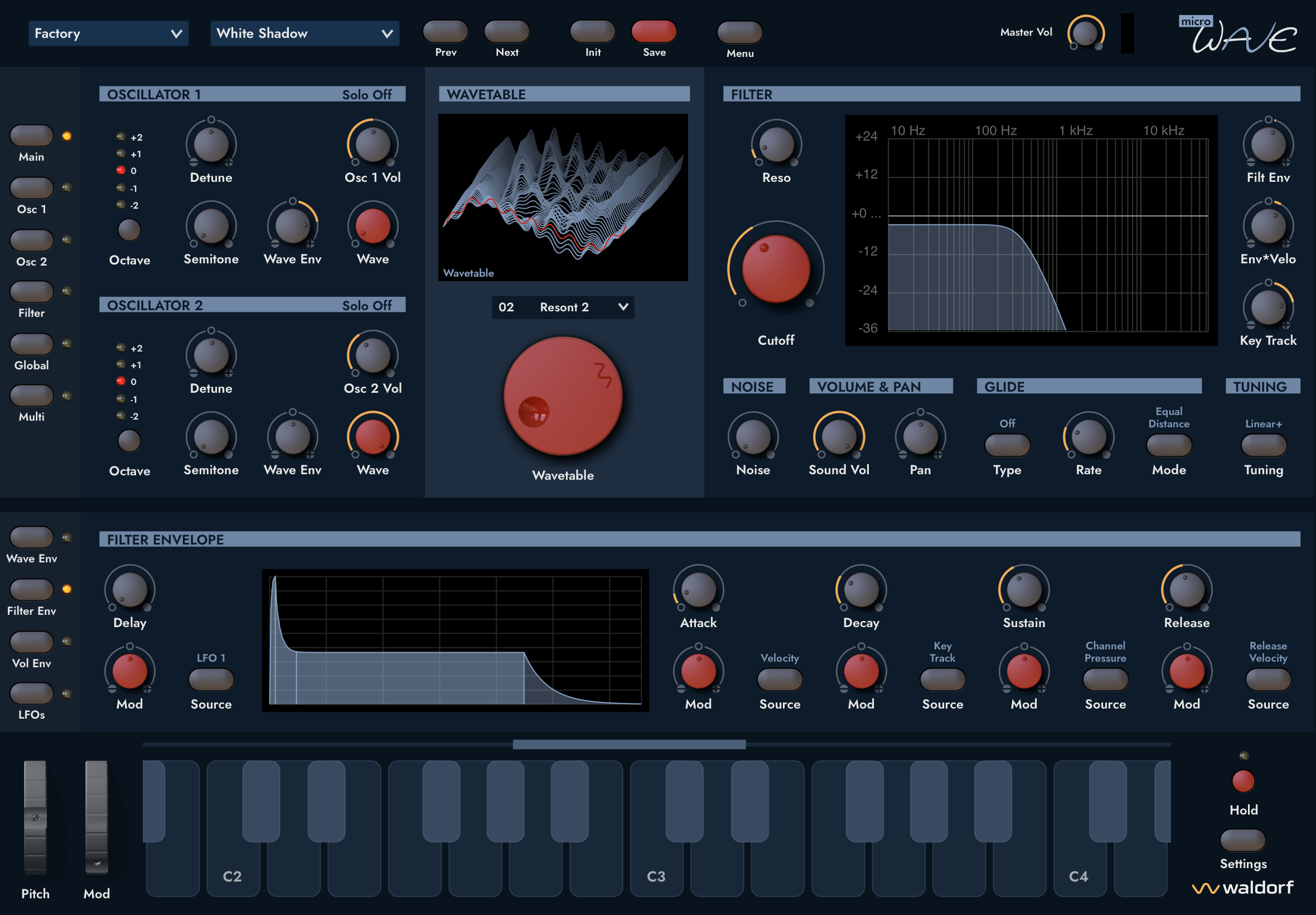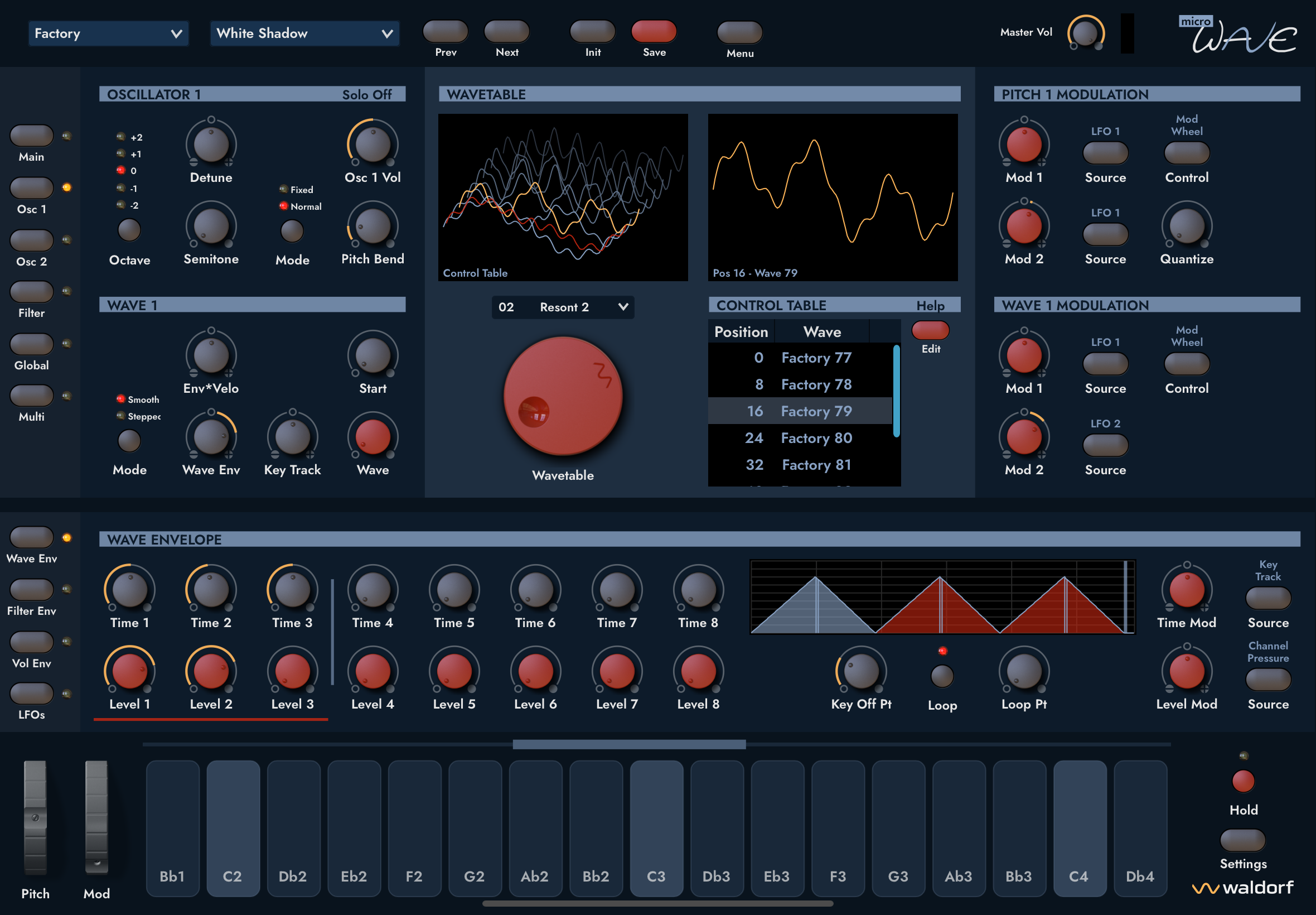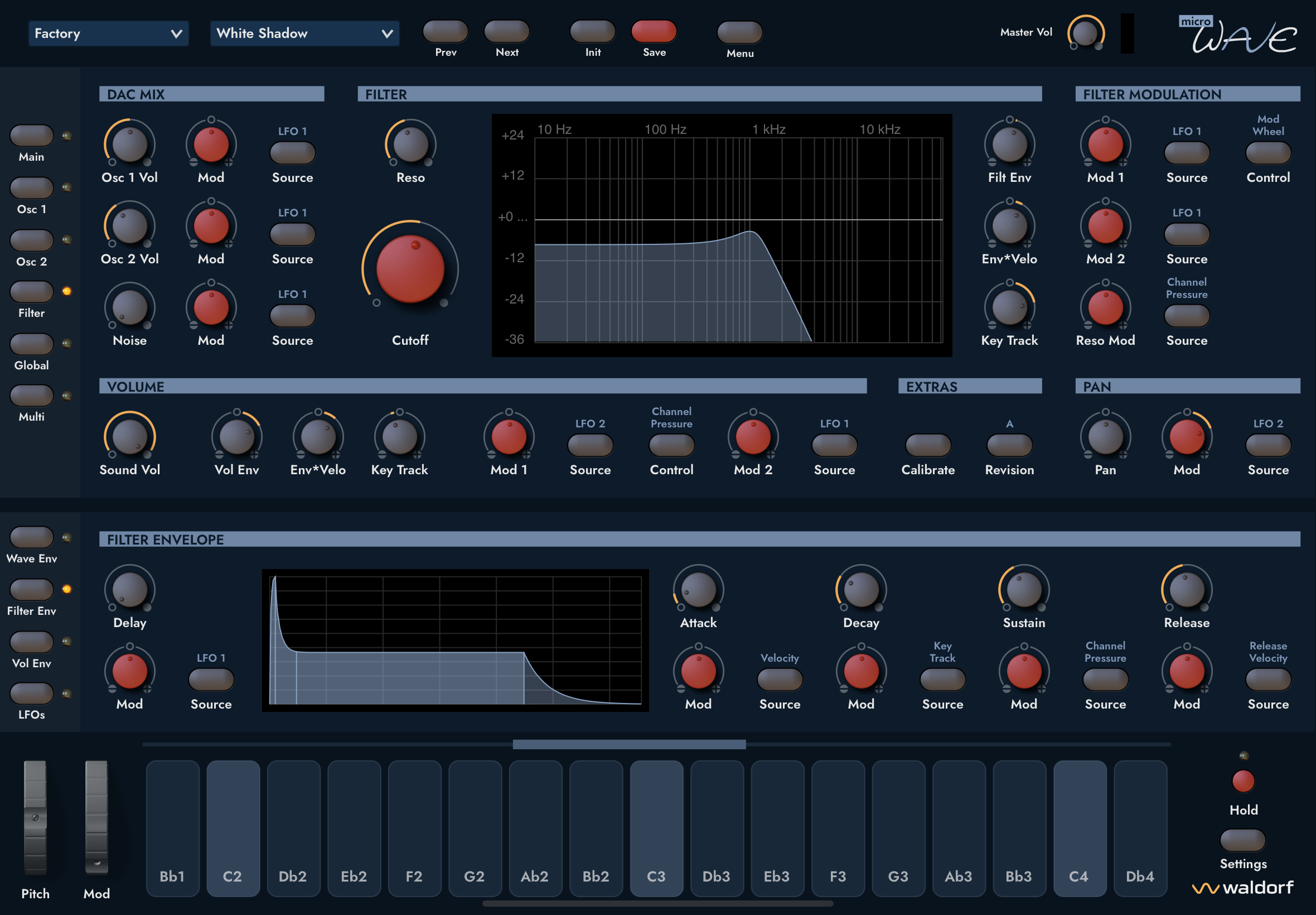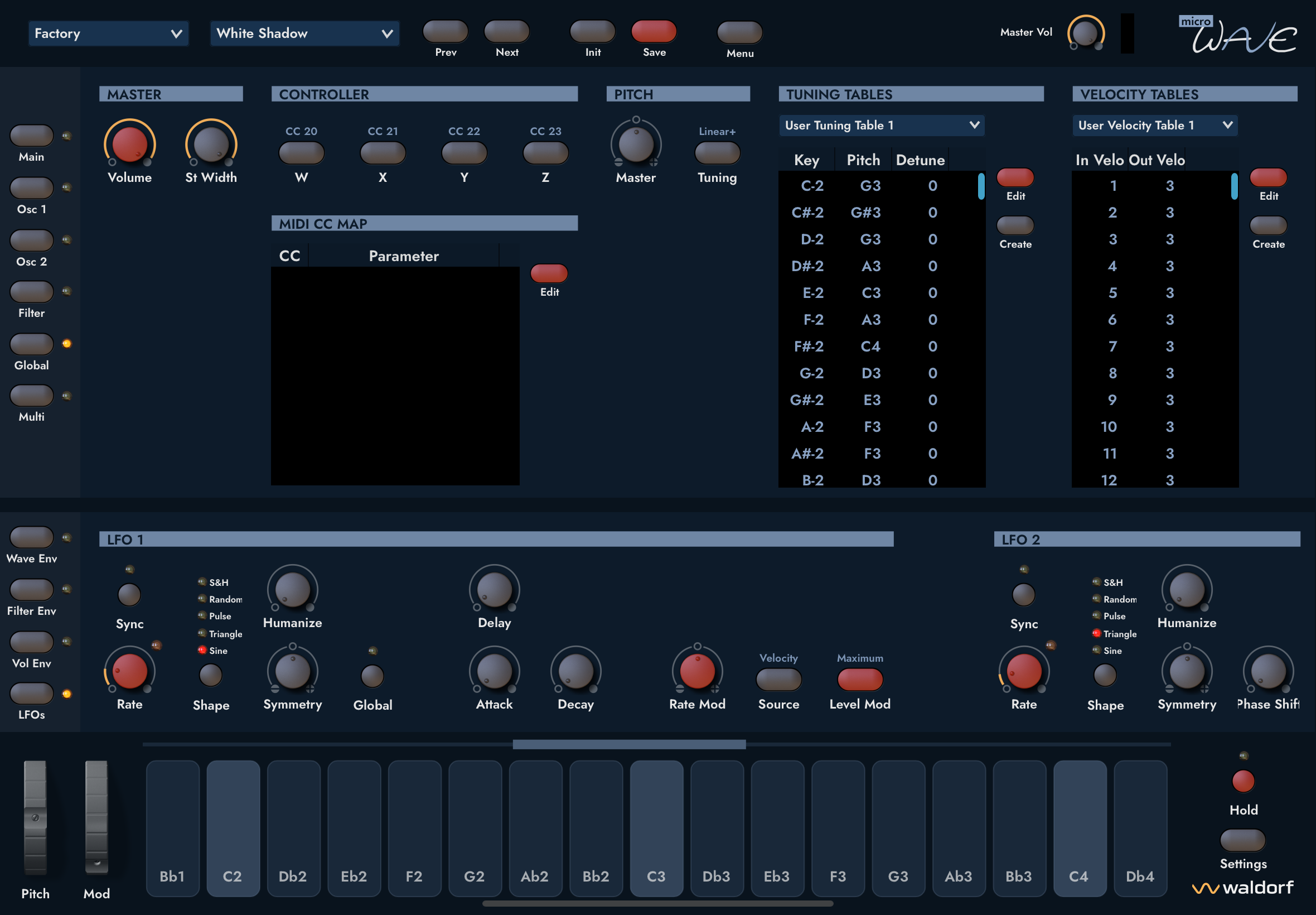
for iPad

Sounddesign first steps with Martin Stürtzer.
Vor 35 Jahren brachte Waldorf Music sein erstes Instrument, den Microwave, heraus, der die Herzen der führenden Musiker und Produzenten der Neunzigerjahre im Sturm eroberte. Sein lebendiger und unverwechselbarer Wavetable Sound der achtziger Jahre beeinflusste massiv die aufkommende elektronische Tanzmusik des folgenden Jahrzehnts. Harte Basslines, rätselhafte Wavetable Modulationen, brutale Attacks und seidenweiche Pads haben Generationen von Musikern inspiriert. Die einzigartige Interpretation der Wavetable Synthese des Microwaves in Kombination mit analogen Filtern definierte, was Hybrid Synthese in ihrer besten Form ist.
Nun ist es an der Zeit, dieses legendäre Instrument in Softwareform auf die digitalen Workstations von Produzenten und Musikern auf der ganzen Welt zurückzubringen. Das Waldorf Microwave 1 iPad wurde in mühevoller Kleinstarbeit auf Basis der Original Hardware mit all ihren Besonderheiten und ihrem wundervollen speziellen Charakter nachgebaut. In mehrjähriger Arbeit und mit viel Liebe wurden die Originalinstrumente bis ins kleinste Detail analysiert und modelliert.
Nur die erste Generation des Microwave und auch der Waldorf Wave basierten auf einem eigens entwickelten integrierten Schaltkreis, dem Waldorf ASIC. In Kombination mit den legendären Curtis Filterchips und einer einzigartigen 68k-CPU-basierten Controller-Software definierte der ASIC eine ganz besondere Art von Wavetable Sound, die ihresgleichen sucht. Kein Geringerer als der Erfinder der Wavetable Synthese der achtziger Jahre, Wolfgang Palm, war an der Entwicklung dieses einzigartigen Chips beteiligt. Waldorf hat sich sehr viel Mühe gegeben, diesen integrierten Schaltkreis zu analysieren und im nun vorliegenden Format nachzubauen. Wie das Original betreibt das Plugin die interne Synthese mit der extrem hohen Samplingrate von 250 kHz, unabhängig von der Samplingrate der DAW. Die nachgebildeten digitalen Wellenformen wurden Bit für Bit mit dem Original verglichen, um 100 % identisch zu sein. Das digitale Rauschen wurde exakt mit all seinen wunderbaren Artefakten nachgebildet.
Selbst die Old-School-Digital-Analog-Wandler der Original Hardware wurden mit ihrem nichtlinearen Verhalten und ihrer speziellen Klangfärbung modelliert wonach der Klang in die in die beiden Curtis-Filterchip-Varianten der Revisionen A und B der Original-Hardware weitergerieicht wurde. Das Plug-in erlaubt darüber hinaus die künstliche Verstimmung und Rekalibrierung der analogen Komponenten. Brutale Attacks, bissige Decays und eine Fülle von wunderbaren Transienten bestimmen den Sound der ersten Generation des Microwave. Sein lebendiger Klang, der nie mechanisch, sondern immer anders klang, basierte auf einer einzigartigen Architektur zur Erzeugung von Hüllkurven,
LFOs und Modulationen, die vom Plug-In bis in das feinsten Detail akribisch nachgebildet wurde. Aber das ist noch nicht alles: Zum ersten Mal wurde das Innenleben des Microwave offengelegt. Basierend auf den internen Steuertabellen kann der Benutzer nun bestehende Wavetables einfach bearbeiten und neue in einem einzigartigen und intuitiven Prozess erstellen. Alle Original-Wavetables sind mit ihren Kontrollstrukturen und dem kompletten Original-Wellenformkatalog verfügbar. Zusätzlich zu den User-Wavetables können auch User-Waveforms innerhalb des Plug-ins erstellt werden. Zusätzliche Randomisierungsmodi machen das Editieren von Wavetables so zugänglich, leicht und klanglich überraschend wie nie zuvor.


Der Multimode wird nun zu einem Geheimtipp für das Sounddesign. Ursprünglich nur schwer über das Bedienfeld zu bearbeiten, ermöglicht die Plugin Benutzeroberfläche nun das schnelle Überlagern einzelner Sounds, um die komplexesten und aufregendsten Klangstrukturen zu erzeugen die man sich vorstellen kann. Eine einfach zu bedienende Mixer-Seite ermöglicht die Feinabstimmung der klanglichen Beziehungen. Selbst exotischere Funktionen wie Tuning- und Velocity-Tabellen wurden implementiert und können in der Benutzeroberfläche bearbeitet werden.
Alle originalen Werks-Single- und -Multi-Mode-Sounds sind in dem Plugin enthalten, kombiniert mit neuen und modernen Sound Presets. Original MIDI- und Sys-Ex-Dump-Dateien können importiert werden, so dass du deine Favoriten aus der Vergangenheit laden kannst. Darüber hinaus kann das Plugin zur Steuerung der Original Hardware als ein grafischer Editor verwendet werden. Wenn du ein glücklicher Besitzer eines Microwave der ersten Generation sind, erlaubt dir das Plugin, deine geliebte Hardware virtuell mitzunehmen, wohin du willst, und deine magischen Sound stets zur Hand zu haben.
Microwave 1 iPad
The Microwave defined hybrid synthesis at its best with its unique interpretation of wavetable synthesis combined with analogue filters. Now Waldorf Music brings this magical instrument back into the hands of musicians with the release of the Microwave 1 app for iPads. It can be used as a standalone app as well as in the iPadOS AUv3 plug-in format.

35 years ago Waldorf Music released its first instrument, the Microwave, which took the hearts of the leading musicians and producers of the nineties by storm. Its vibrate and distinctive sound transported the early wavetable sounds of the eighties into the rising electronic dance music of the following decade. Massive base lines, enigmatic wavetable modulations, brutal attacks and pads smooth like silk have been inspired generations of musicians. Microwave’s unique interpretation of wavetable synthesis combined with analogue filters defined what hybrid synthesis is at its best.
Now’s the time to bring back this magical instrument in a software form into the hands of producers and musicians world-wide. The Waldorf Microwave 1 Plugin was painstakingly recreated from the original hardware with all its idiosyncrasies and wonderful singularities.

A multi-year effort and a labor of love which analyzed and modeled the original instruments down to the finest sonic details of every aspect of the hardware. Only the first generation of the Microwave and also the Waldorf Wave were based on a custom developed integrated circuit called the Waldorf ASIC. In combination with the legendary Curtis filter chips and a very unique 68k CPU based controller software the ASIC defined a very special flavor of wavetable sound unparalleled to none. No one else than the inventor of Wavetable Synthesis of the eighties, Wolfgang Palm, helped to design this unique chip. Waldorf took a huge effort to analyze and recreate this integrated circuit within the software version. As the original, the app runs the internal synthesis with the ultra high sampling rate of 250 kHz regardless of the DAW sampling rate. The recreated digital waveforms have been bit-by-bit compared with the original to be 100% identical.

Even the old-school digital-to-analogue converters of the original hardware were modeled with their non-linearities and tone shaping color which were leading into the two Curtis filter chips variants used for the revisions A and B of the original hardware. The plug-in allows further for artificially detuning and recalibrating of the analogue components. Brutal attacks, snappy decays and a plethora of wonderful transients define the sound of the first generation Microwave. But the Microwave 1 iPad app goes one step further: Its modern and inviting graphical user-interface reveals many aspects of the synthesis engine which were hidden before in the original hardware by its sparse hard to use interface.

ood never sounding mechanical but always different was based on a very unique architecture to create the envelopes, LFOs and modulations which was painstakingly recreated by the app down to the finest grains.
A fully scalable modern interface with readable high-contrast fonts supports an intuitive sound editing process with many graphical representations of the wavetables, envelopes and filter response curves using animations for modulations and playing positions. The Microwave 1 was never as close as this under your finger tips. A joy to edit sounds with.

But we stopped not here, for the first time the inner makings of the Microwave have been put to the surface. Based on the internal control tables the user can now easily edit existing wavetables and create new ones in a very unique and intuitive process. All the original wavetables are available with their control structures and the full original waveform catalogue. In addition to user wavetables, also user waveforms can be created within the software. Additional randomization modes make wavetable editing fun and sonically surprising as experienced never before. The multi-mode becomes now a weapon of its own for sound design. Originally hard to edit from the panel, the UI allows now for quickly layering of single sounds to create the most complex and exciting sonic structures.
An easy to use mixer page lets you fine tune their sonic relationships. Even the more exotic feature like tuning and velocity tables have been implemented and can be edited in the UI. All the original factory single and multi-mode sounds are contained in the app in combination with new and modern sound presets. Original MIDI and Sys-Ex dump files can be imported such you can load your favorites from the past. Moreover, the app can be used to control the original hardware are a graphical editor. If you a lucky owner of an Microwave first generation, the app allows you to take your beloved hardware virtually with you where-ever you like and keeping its magical sound. The Microwave 1 iPad app can be used as a standalone app as well as in the iPadOS AUv3 plug-in format.


